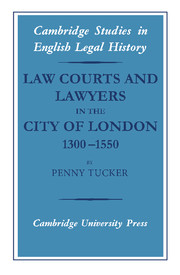Book contents
- Frontmatter
- Contents
- Acknowledgements
- List of abbreviations
- List of figures
- Introduction
- 1 The administration of the law by the city in context
- 2 The distinctiveness of city law and custom
- 3 The city law courts
- 4 The administration of the law in the city's courts: I
- 5 The administration of the law in the city's courts: II
- 6 Judges, jurors and litigants
- 7 The city's law officers
- 8 Legal representation in the city
- 9 The effectiveness of the administration of the law by the city
- 10 Interchange and exchange between the city and the common law
- Appendices
- Bibliography
- Index
8 - Legal representation in the city
Published online by Cambridge University Press: 04 August 2010
- Frontmatter
- Contents
- Acknowledgements
- List of abbreviations
- List of figures
- Introduction
- 1 The administration of the law by the city in context
- 2 The distinctiveness of city law and custom
- 3 The city law courts
- 4 The administration of the law in the city's courts: I
- 5 The administration of the law in the city's courts: II
- 6 Judges, jurors and litigants
- 7 The city's law officers
- 8 Legal representation in the city
- 9 The effectiveness of the administration of the law by the city
- 10 Interchange and exchange between the city and the common law
- Appendices
- Bibliography
- Index
Summary
INTRODUCTION
In 1300, there were three main types of function undertaken by legal representatives in court: advocacy, personal substitution, and excusing absence. An advocate spoke for his client in the client or attorney's presence and his pleadings could be ‘disavowed’ or repudiated, whereas the attorney substituted for his client, his words and actions being as binding as the client's own, and an essoiner excused the absences of both the litigant and his attorney.
The one place in the city in which legal representatives were definitely not permitted to appear, certainly by the later fourteenth century, was the Inner Chamber; and the only types of cases in which they were definitely never permitted to act formally for their clients were those heard and determined according to merchant law or conscience. It is likely enough that legal representatives had never appeared in such cases, and that it was the increase and formalisation of the activities of the Mayor's Court which made it necessary to clarify the situation, rather than any change in practice. The explanation given for the restriction in 1390, that the mayor and aldermen wished ‘to examine [the parties in such cases] … and put questions to them [on oath] and to use other means of eliciting the truth … without any counsel or any other form of plea’, probably does accurately reflect their motivation.
- Type
- Chapter
- Information
- Law Courts and Lawyers in the City of London 1300–1550 , pp. 272 - 313Publisher: Cambridge University PressPrint publication year: 2007



